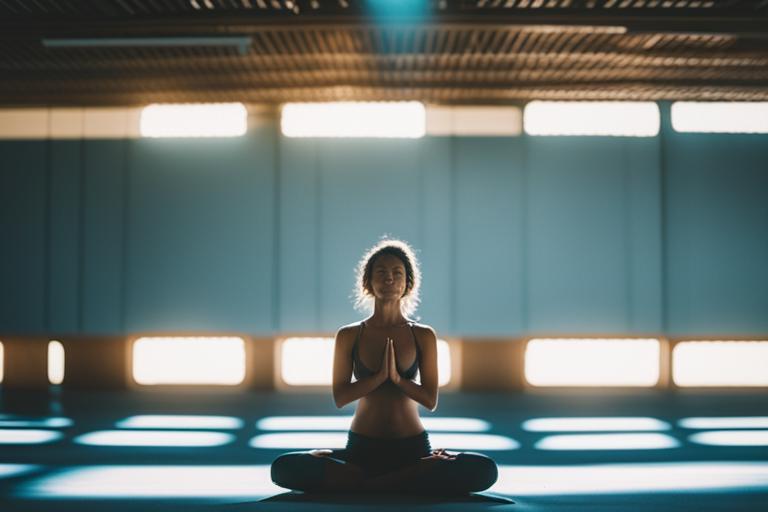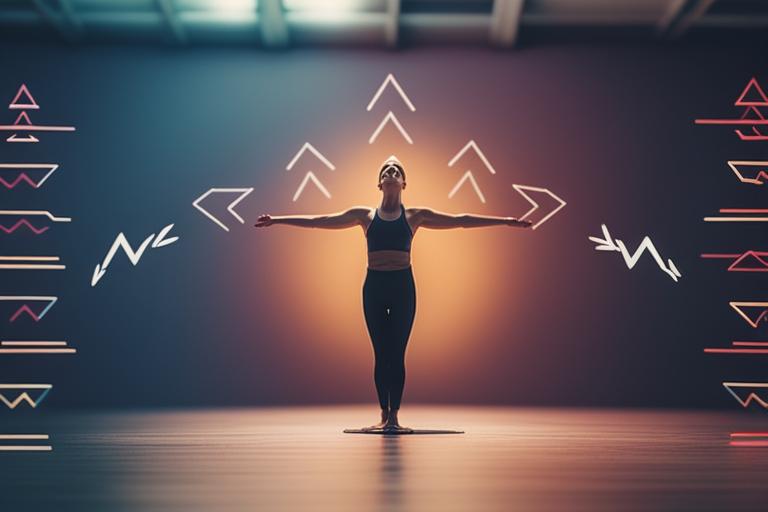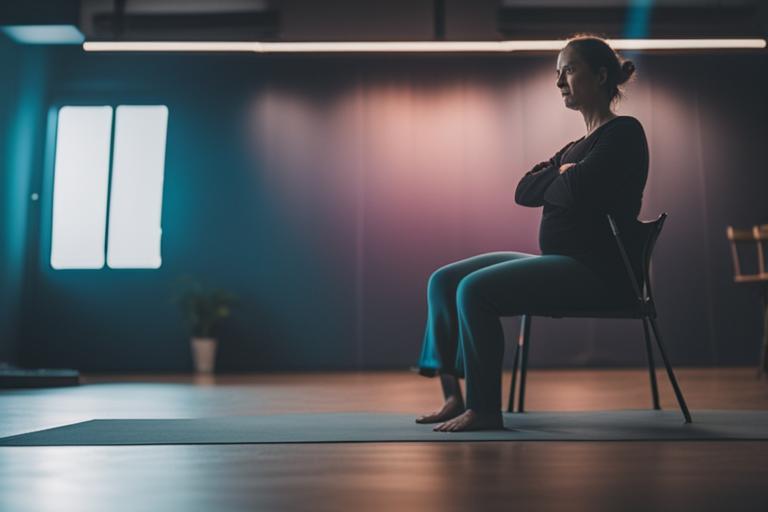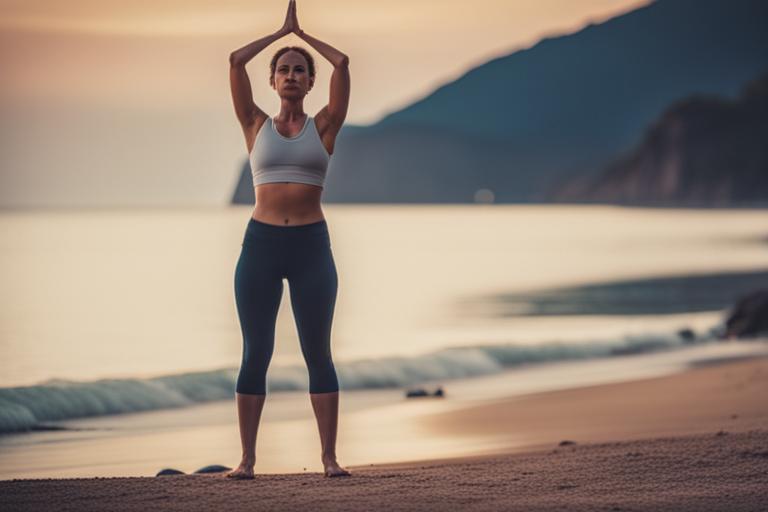Are you looking for a yoga pose to improve your posture and body awareness? Look no further than Tadasana, also known as Mountain Pose. Tadasana is a fundamental yoga posture that promotes better posture, body awareness, and alignment. It’s considered the foundation of all yoga postures and is essential for grounding and alignment in yoga practice.
As a certified yoga instructor, I have seen the benefits of Tadasana firsthand. In this article, I’ll explore the step-by-step instructions for Tadasana, its benefits, modifications, and variations, as well as its rich history and philosophy in yoga.

How to Perform Tadasana Step-by-Step
Tadasana is a simple yet powerful pose that involves standing tall with your feet firmly planted on the ground. Here are the step-by-step instructions for the pose:
-
- Start by standing at the top of your mat with your feet hip-distance apart and your arms by your sides.
-
- Ground your feet firmly into the ground and distribute your weight evenly between both feet.
-
- Engage your thigh muscles and rotate them slightly inward.
-
- Draw your tailbone down towards the ground to lengthen your spine.
-
- Lift your chest and roll your shoulders back and down.
-
- Relax your arms and let them hang by your sides.
-
- Soften your gaze and focus on your breath.
To maintain proper alignment in Tadasana, follow these tips:
-
- Keep your feet hip-distance apart and parallel to each other.
-
- Distribute your weight evenly between both feet.
-
- Engage your thigh muscles and rotate them slightly inward.
-
- Draw your tailbone down towards the ground to lengthen your spine.
-
- Lift your chest and roll your shoulders back and down.
-
- Keep your arms relaxed and your gaze soft.
Breathing techniques can also enhance the pose. As you inhale, imagine your breath traveling up through the soles of your feet and into your body. As you exhale, imagine your breath traveling down through the crown of your head and out through the soles of your feet.
Common mistakes to avoid in Tadasana include leaning forward, rounding the shoulders, and not keeping the feet firmly planted on the ground. If you notice any of these misalignments, correct them by engaging your core, lifting your chest, and grounding your feet.
| Physical Benefits | Mental Benefits |
|---|---|
| Improves posture | Promotes focus and mindfulness |
| Enhances balance | Reduces stress and anxiety |
| Strengthens muscles | |
Tadasana
- Tadasana, also known as Mountain Pose, is a foundational yoga pose that improves posture, balance, and promotes mindfulness.
- The article provides step-by-step instructions, benefits, modifications, variations, preparatory poses, and the history and philosophy behind Tadasana.
- It encourages incorporating Tadasana into a regular yoga practice for optimal physical and mental health.

Physical and Mental Benefits of Tadasana
Tadasana has numerous physical and mental health benefits. Here are some of the most notable:
-
- Improves posture: Tadasana strengthens the muscles in your legs, core, and back, which helps improve your posture and alignment.
-
- Enhances balance: By grounding your feet firmly into the ground, Tadasana helps improve your balance and stability.
-
- Strengthens muscles: The pose engages the muscles in your legs, core, and back, which helps strengthen and tone your body.
-
- Promotes focus and mindfulness: Tadasana requires concentration and focus, helping to promote mindfulness and reduce stress.
-
- Reduces stress and anxiety: The pose promotes relaxation and can help reduce stress and anxiety.
However, it’s important to note that certain health conditions may limit or prevent individuals from performing Tadasana. For example, those with low blood pressure or dizziness may need to modify the pose, and those with an injury or medical condition should consult with a healthcare provider before attempting the pose.

Modifications and Variations of Tadasana
Modifications and variations of Tadasana can make the pose more accessible for those with injuries or physical limitations. Here are some common modifications and variations:
-
- Using props such as blocks or straps: Props can help support your body and make the pose more accessible.
-
- Variations for pregnant women or people with injuries: Pregnant women or those with injuries may need to modify the pose by widening their stance or placing their hands on their hips.
-
- Lifting the arms overhead or placing the hands on the hips: These variations can help increase the challenge of the pose and engage different muscles.
It’s important to listen to your body and modify the pose as needed to prevent injury.
Preparatory Poses for Tadasana
Preparatory poses can help prepare your body for Tadasana and improve your overall yoga practice. Here are a few preparatory poses to try:
-
- Savasana: Lie on your back with your arms by your sides and your legs extended. This pose promotes relaxation and can help reduce stress and anxiety.
-
- Cat and Cow: Come onto your hands and knees and alternate between arching your back and rounding your spine. This pose helps warm up your spine and engage your core muscles.
-
- Downward Facing Dog: Come onto your hands and knees and lift your hips up and back to create an inverted V-shape with your body. This pose helps stretch your hamstrings and calves and can help improve your posture.
How to Incorporate Tadasana into a Yoga Sequence
Tadasana can be incorporated into a yoga sequence as a starting point for standing poses such as Warrior I and II. Here is a sample sequence using Tadasana as a starting point:
-
- Tadasana
-
- Warrior I
-
- Warrior II
-
- Extended Side Angle Pose
-
- Triangle Pose
-
- Tree Pose
-
- Savasana
It’s essential to practice mindful transitions between poses and to listen to your body to prevent injury.

The History and Philosophy behind Tadasana in Yoga
Tadasana has a rich history and symbolism in yoga. The pose represents stability, strength, and groundedness, and is often associated with the mountains of India, where yoga originated.
Incorporating the philosophy behind Tadasana into your practice can help promote mindfulness and inner peace. By focusing on your breath and grounding your body, you can cultivate a sense of calm and connection.
Personal Experience: Overcoming Posture Issues with Tadasana
As someone who spends most of their day sitting in front of a computer, I struggled with poor posture and back pain for years. I tried different exercises and stretches, but nothing seemed to work. That was until I discovered Tadasana.
At first, I found it challenging to stand still in Tadasana for more than a few seconds. My mind would start to wander, and I would lose my balance. But with practice, I began to notice subtle changes in my body and mind.
I found myself standing taller, with my shoulders relaxed and my chest open. My back pain started to diminish, and I felt more energized throughout the day. I also noticed that my mind was more focused and clear, allowing me to be more productive at work.
Now, Tadasana has become a foundation of my daily routine. Whenever I start to feel tension in my back or shoulders, I take a few minutes to stand in Tadasana and focus on my breath. It’s a simple yet powerful practice that has transformed my physical and mental well-being.
I encourage anyone who struggles with poor posture or back pain to give Tadasana a try. With patience and dedication, this foundational yoga pose can help you overcome your posture issues and improve your overall health.
Conclusion
Mountain Pose, or Tadasana, is a foundational yoga pose that can have significant physical and mental health benefits. By regularly incorporating this pose into your yoga practice, you can improve your posture, balance, and strength, and reduce stress and anxiety.
Remember to listen to your body and modify the pose as needed to prevent injury. And don’t forget to practice mindful transitions between poses and to focus on your breath to promote mindfulness and inner peace.
If you’re new to yoga, consider taking a class with an experienced teacher to learn proper alignment and technique. With regular practice, Tadasana can become a powerful tool for overall well-being.
Insider Tip: “Don’t be afraid to play with this pose, and make it your own. See how it feels to take a wider stance or lift the arms overhead. By exploring the pose, you can deepen your understanding of your body and your yoga practice.”
FAQs
Q: Who should practice mountain pose?
A: Anyone looking to improve posture and balance.
Q: What are the benefits of practicing tadasana?
A: It strengthens the legs and core, improves posture, and reduces stress.
Q: How do I properly do mountain pose?
A: Stand with feet hip-width apart, arms at sides, and lift through the crown of your head.
Q: Who should avoid practicing tadasana?
A: Those with low blood pressure or dizziness should modify or skip the pose.
Q: What if I can’t reach my hands to the floor?
A: Place hands on hips or use a block to bring the floor closer to you.
Q: How does mountain pose prepare me for other poses?
A: It serves as the foundation for many standing poses in yoga.







